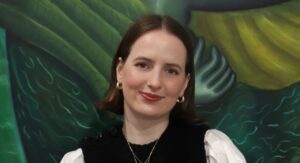This website uses cookies so that we can provide you with the best user experience possible. Cookie information is stored in your browser and performs functions such as recognising you when you return to our website and helping our team to understand which sections of the website you find most interesting and useful.
A Blank Canvas: the female gallerists reframing the art world
By Tempus | 2 March 2023 | Culture
In a field often dominated by men, the women of Pictorum Art Group share their future focus as the brand launches its London flagship gallery and prepares for international expansion

Jenna McDonald, Creative Director, Pictorum Art Group
JENNA MCDONALD | CREATIVE DIRECTOR
What are your aims for Pictorum Art Group?
As creative director at Pictorum Art Group, I am continuously looking towards the bigger-picture for the Group and our brands. Creativity and strategy go hand in hand in my role. I focus on developing a vision that ensures we have a cohesive image that embodies our brands’ various identities – such as overseeing the design and construction of Pictorum Gallery London. I also conceive and deliver projects that put us in alignment with individuals, brands and organisations we resonate with. I aim to form meaningful relationships that last with all – no matter how big or small the project or collaboration is – and to form a culture that encourages creativity and flexibility that I hope results in a fulfilling atmosphere for everyone in the team.
Why is it so important to have women involved the art market ecosystem?
I think it’s essential that all industries include the perspectives and opinions of all people, for only then can you start to bring true transformative change. It’s so important to have a working environment where women can feel free to be bold, take risks and think outside the norm. Women’s perception to life and work will always be unique and in order to bring an ecosystem to equilibrium, their involvement welcomed and encouraged.
How does this relate to the role of women in different artistic movements?
It’s no secret that the art world (like many other industries) has been dominated by men throughout history. Take for example, the abstract movement; we hear names like Kandinsky, Willem de Kooning and Pollock but what about Hilma af Klint, Agnes Martin and de Kooning’s wife, Elaine? Art will forever be encircled by questions and considerations – what kind of space should art be viewed? Should we view the work solely for its aesthetics or is it important to know the story behind? I feel that there will never be a definitive answer for any of these – but, also, that there should not be. Art is so subjective, and I believe its beauty lies in that.
What are you most excited for in 2023?
We have a lot of exciting things in the pipeline for 2023. Already, we have participated in UVNT Madrid showcasing three artists – Yaya Yajie Liang, Ornella Poccetti and Johanna Seidel–who are also showing with us in London. In March, we launched our first International Women’s Day event at AllBright, and we are looking to launch our vision internationally later in the year, with operations in India and potentially Dubai.

Sanaa Sachdev, Operations Director, Pictorum Art Group
SANAA SACHDEV | OPERATIONS DIRECTOR
Tell us about your role within the Group?
My role at Pictorum has evolved over the last 18 months. I started in business development and marketing and now manage operations and logistics. One of the perks of working in a small team is that you can try different areas within the business and see where you can give the best outcome. Managing the internal function of each of our brands helps me understand them better, and gives me a sense of achievement to know that smoothly running operations strengthens the backbone of the company. I also work on investment modelling for our advisory, and it’s exciting to learn more as this role grows.
What do you feel is the biggest misconception about the art world?
Art is often seen as progressive and liberal, yet industry tastemakers are considered rigid and elitist. This perception is also reflected in how people invest and collect art. One of the reasons art collecting is still considered a hobby for the rich and renowned is because of the lack of knowledge and buying power among wider art admirers. However, if you start small, you can support phenomenally talented emerging artists who are often overlooked because amateur collectors are distracted by blue chip art.
How can organisations help bridge this gap?
In my opinion, the disconnect between how the art world is perceived and how it traditionally operates is that the rule-makers are no longer the tastemakers. Age-old institutions are run by older generations who are understandably resistant to change but, as tastes and ideas evolve, perceptions of those producing and buying art are becoming incongruent with the older generations running these institutions. To initiate disruptive changes relevant to the new generation of art lovers, new organisations need to follow a more collaborative approach than a competitive one.
What are the biggest challenges for underrepresented people in the art market?
Passion may be the prominent motivator for creators and collectors, but it isn’t the factor that bridges the supply and demand gap between them. For an artist to make a living out of their passion, they also need to learn how to commercialise their work and make their talent known. Equally, until recently, women artists were not taken as seriously as their male counterparts, but that seems to be changing as organisations make more conscious effort to eliminate the gender gap. Tate Britain recently announced that it will showcase works by more women artists than ever before – an effort evident of a slow change that acknowledges women to be equally qualified in their practice.

Josephine-May Bailey, Gallery Director & Curator, Pictorum Art Group
JOSÉPHINE-MAY BAILEY | GALLERY DIRECTOR & CURATOR
Tell us about the ethos of Pictorum Gallery?
Mutual support is at the core of Pictorum. We work alongside our artists to ensure their longevity and, as a gallery that works with emerging artists, this is especially important. There is a lot of talk around ‘finding’ new artists, but sometimes this creates a culture that’s so fast moving artists can quickly be forgotten. We bring our artists with us every step of the way. We are also dedicated to supporting women and artists of colour and ensure that our programme reflects this.
What do you love about working with emerging artists?
It’s important for me to represent emerging artists, as often they need the most guidance and support. I take great pride in building secure, trusting relationships with my artists. Working with emerging artists is immensely rewarding. It feels incredible to make a difference in each artist’s practice by ensuring their works go to collectors who want to support them and help them develop. I have had the privilege of working with some of the most successful emerging artists today, and I still get goosebumps when I see them showing at major galleries.
Are women artists underrepresented?
The art world is years behind many other industries in terms of gender equality. While there’s been a recent shift towards women artists, they are often still vastly under-appreciated in terms of value in the primary and secondary markets, as well as exhibitions and institutional shows. According to Tate, 78% of London galleries represent more men than women, while only 5% represent an equal number of male and female artists. Similarly, according to Artnet.com, men outnumbered women 85 to 15 on the top-selling artists at auction in 2020 and, despite making up 54% of all artists, women artists represent just 2% of the market. These stats are just the tip of the iceberg and showcase something that we have all noticed over the years.
How do you plan to shift the balance?
A focus on women artists will be a cornerstone of our programming. Of the nine shows we have planned for 2023, seven are women-only exhibitions. These exhibitions aren’t simply groups of women lumped together as ‘great women artists’, but highly researched exhibitions focusing on topics and themes that are deeply rooted in the chosen artists’ practices. In March, our exhibition The Songs of Hecate features seven women artists focusing on how understandings of mysticism and spiritualism build a sense of community and knowledge sharing; consequently rejecting patriarchal oppression. It is an exhibition that really deserves attention and focus, and I am so proud to be working with the artists.
Pictorum Gallery London is located at 2 Portman Square, London
Find out more about Pictorum Art Group by contacting: jenna@pictorum.art
Discover more artist interviews and exhibitions with Tempus

Sanaa, Josephine-May, and Jenna, Pictorum Art Group







